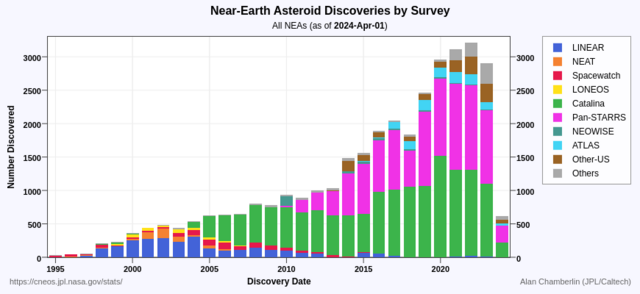Catalina Sky Survey
Project to discover comets, asteroids, and near-Earth objects From Wikipedia, the free encyclopedia
Project to discover comets, asteroids, and near-Earth objects From Wikipedia, the free encyclopedia
Catalina Sky Survey (CSS; obs. code: 703) is an astronomical survey to discover comets and asteroids. It is conducted at the Steward Observatory's Catalina Station, located near Tucson, Arizona, in the United States.
 | |
| Alternative names | CSS |
|---|---|
| Coordinates | 32°25′01″N 110°43′59″W |
| Observatory code | 703 |
| Website | catalina |
| see § List of discovered minor planets |
CSS focuses on the search for near-Earth objects, in particular on any potentially hazardous asteroid that may pose a threat of impact. Its counterpart in the southern hemisphere was the Siding Spring Survey (SSS), closed in 2013 due to loss of funding. CSS supersedes the photographic Bigelow Sky Survey.

|
LINEAR NEAT Spacewatch LONEOS |
CSS Pan-STARRS NEOWISE All others |
The NEO Observations Program is a result of a United States 1998 congressional directive to NASA to begin a program to identify objects 1 kilometer (0.62 miles) or larger to a confidence level of 90% or better. The Catalina Sky Survey, located at the Mount Lemmon Observatory in the Catalina Mountains north of Tucson, carries out searches for near-earth objects (NEOs), contributing to the congressionally-mandated goal.
In addition to identifying impact risks, the project also obtains other scientific information, including: improving the known population distribution in the main belt, finding the cometary distribution at larger perihelion distances, determining the distribution of NEOs as a product of collisional history and transport to the inner Solar System, and identifying potential targets for flight projects.
The Catalina Sky Survey (CSS) uses three telescopes, a 1.5-meter (59 in) f/1.6 telescope on the peak of Mount Lemmon (MPC code G96), a 68 cm (27 in) f/1.7 Schmidt telescope near Mount Bigelow (MPC code 703), and a 1-meter (39 in) f/2.6 follow-up telescope also on Mount Lemmon (MPC code I52). The three telescopes are located in the Santa Catalina Mountains near Tucson, Arizona. The CSS southern hemisphere counterpart, the Siding Spring Survey (SSS), used a 0.5-meter (20 in) f/3 Uppsala Schmidt telescope at Siding Spring Observatory in Australia. The 1.5-meter and 68-cm survey telescopes use identical, thermo-electrically cooled cameras and common software written by the CSS team. The cameras are cooled to approximately −100 °C (−148 °F) so their dark current is about 1 electron per hour. These 10,560×10,560-pixel cameras provide a field of view of 5 square degrees with the 1.5-m telescope and nearly 20 square degrees with the Catalina Schmidt. Nominal exposures are 30 seconds and the 1.5-m can reach objects fainter than 21.5 V in that time.[2] The 1-meter follow-up telescope uses a 2000×2000-pixel CCD detector which provides a field of view of 0.3 square degrees. Starting in 2019, CSS started using the 1.54-meter (61 in) Kuiper telescope situated on Mt. Bigelow for targeted follow-up for 7–12 nights per lunation.
CSS typically operates every clear night with the exception of a few nights centered on the full moon. The southern hemispheres' SSS in Australia ended in 2013 after funding was discontinued.[3]
In 2005, CSS became the most prolific NEO survey, surpassing Lincoln Near-Earth Asteroid Research (LINEAR) in total number of NEOs and potentially hazardous asteroids discovered each year since. As of 2020, the Catalina Sky Survey is responsible for the discovery of 47% of the total known NEO population.[4]
| Minor planet | Discovery date | Description |
|---|---|---|
| 2006 JY26 | May 6, 2006 | Nearly missed the Moon and the Earth on May 9–10, 2006, and may impact the Earth on May 3, 2073.[5] |
| 2007 WD5 | November 20, 2007 | Nearly missed Mars on January 9, 2008 [6][7] |
| 2008 TC3 | October 6, 2008 | Struck Earth on October 7, 2008 [8] |
| 2012 XE133 | December 12, 2012 | Currently a temporary co-orbital of Venus.[9] |
| 2014 AA | January 1, 2014 | Struck Earth on January 2, 2014.[10][11][12] |
| 2018 LA | June 2, 2018 | Struck Earth on June 2, 2018.[13] |
| 2024 RW1 | September 4, 2024 | Struck Earth on September 4, 2024.[14] |
For a complete listing of all minor planets discovered by the Catalina Sky Survey, see the index section in list of minor planets.
The CSS team is headed by D. Carson Fuls of the Lunar and Planetary Laboratory of the University of Arizona.[15]
The full CSS team is:
The CSS has helped with Astronomy Camp by showing campers how they detect NEOs. They even played a role in an astrophotography exercise with the 2006 Adult Astronomy Camp ending up with a picture that was featured on Astronomy Picture of the Day.[16]
The Zooniverse project Catalina Outer Solar System Survey[17] is a citizen science project and is listed as a NASA citizen science project.[18] In this project, the volunteers search for trans-Neptunian objects (TNOs) in pre-processed images of the Catalina Sky Survey. Computers can detect the motion of TNOs, but humans must check whether this motion is real.[19][20] Upon agreement with the volunteers, they will be cited as "measurers" in the submission of the astrometry to the Minor Planet Center.[21] The project already found previously known TNOs, including 47171 Lempo, (445473) 2010 VZ98, and (144897) 2004 UX10.[22]
Seamless Wikipedia browsing. On steroids.
Every time you click a link to Wikipedia, Wiktionary or Wikiquote in your browser's search results, it will show the modern Wikiwand interface.
Wikiwand extension is a five stars, simple, with minimum permission required to keep your browsing private, safe and transparent.